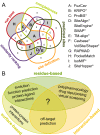A benchmark driven guide to binding site comparison: An exhaustive evaluation using tailor-made data sets (ProSPECCTs)
- PMID: 30408032
- PMCID: PMC6224041
- DOI: 10.1371/journal.pcbi.1006483
A benchmark driven guide to binding site comparison: An exhaustive evaluation using tailor-made data sets (ProSPECCTs)
Abstract
The automated comparison of protein-ligand binding sites provides useful insights into yet unexplored site similarities. Various stages of computational and chemical biology research can benefit from this knowledge. The search for putative off-targets and the establishment of polypharmacological effects by comparing binding sites led to promising results for numerous projects. Although many cavity comparison methods are available, a comprehensive analysis to guide the choice of a tool for a specific application is wanting. Moreover, the broad variety of binding site modeling approaches, comparison algorithms, and scoring metrics impedes this choice. Herein, we aim to elucidate strengths and weaknesses of binding site comparison methodologies. A detailed benchmark study is the only possibility to rationalize the selection of appropriate tools for different scenarios. Specific evaluation data sets were developed to shed light on multiple aspects of binding site comparison. An assembly of all applied benchmark sets (ProSPECCTs-Protein Site Pairs for the Evaluation of Cavity Comparison Tools) is made available for the evaluation and optimization of further and still emerging methods. The results indicate the importance of such analyses to facilitate the choice of a methodology that complies with the requirements of a specific scientific challenge.
Conflict of interest statement
The authors have declared that no competing interests exist.
Figures















Similar articles
-
SiteMine: Large-scale binding site similarity searching in protein structure databases.Arch Pharm (Weinheim). 2024 May;357(5):e2300661. doi: 10.1002/ardp.202300661. Epub 2024 Feb 9. Arch Pharm (Weinheim). 2024. PMID: 38335311
-
Forging the Basis for Developing Protein-Ligand Interaction Scoring Functions.Acc Chem Res. 2017 Feb 21;50(2):302-309. doi: 10.1021/acs.accounts.6b00491. Epub 2017 Feb 9. Acc Chem Res. 2017. PMID: 28182403
-
Benchmark data sets for structure-based computational target prediction.J Chem Inf Model. 2014 Aug 25;54(8):2261-74. doi: 10.1021/ci500131x. Epub 2014 Aug 1. J Chem Inf Model. 2014. PMID: 25084060
-
Exploring the potential of global protein-protein docking: an overview and critical assessment of current programs for automatic ab initio docking.Drug Discov Today. 2015 Aug;20(8):969-77. doi: 10.1016/j.drudis.2015.03.007. Epub 2015 Mar 20. Drug Discov Today. 2015. PMID: 25801181 Review.
-
Can We Rely on Computational Predictions To Correctly Identify Ligand Binding Sites on Novel Protein Drug Targets? Assessment of Binding Site Prediction Methods and a Protocol for Validation of Predicted Binding Sites.Cell Biochem Biophys. 2017 Mar;75(1):15-23. doi: 10.1007/s12013-016-0769-y. Epub 2016 Oct 31. Cell Biochem Biophys. 2017. PMID: 27796788 Review.
Cited by
-
Computational methods and tools for binding site recognition between proteins and small molecules: from classical geometrical approaches to modern machine learning strategies.J Comput Aided Mol Des. 2019 Oct;33(10):887-903. doi: 10.1007/s10822-019-00235-7. Epub 2019 Oct 18. J Comput Aided Mol Des. 2019. PMID: 31628659
-
TWN-RENCOD: A novel method for protein binding site comparison.Comput Struct Biotechnol J. 2022 Dec 19;21:425-431. doi: 10.1016/j.csbj.2022.12.014. eCollection 2023. Comput Struct Biotechnol J. 2022. PMID: 36618985 Free PMC article.
-
Deciphering interaction fingerprints from protein molecular surfaces using geometric deep learning.Nat Methods. 2020 Feb;17(2):184-192. doi: 10.1038/s41592-019-0666-6. Epub 2019 Dec 9. Nat Methods. 2020. PMID: 31819266
-
VirtuousPocketome: a computational tool for screening protein-ligand complexes to identify similar binding sites.Sci Rep. 2024 Mar 15;14(1):6296. doi: 10.1038/s41598-024-56893-7. Sci Rep. 2024. PMID: 38491261 Free PMC article.
-
ProteinsPlus: a publicly available resource for protein structure mining.Nucleic Acids Res. 2025 Jul 7;53(W1):W478-W484. doi: 10.1093/nar/gkaf377. Nucleic Acids Res. 2025. PMID: 40326518 Free PMC article.
References
Publication types
MeSH terms
Substances
LinkOut - more resources
Full Text Sources

